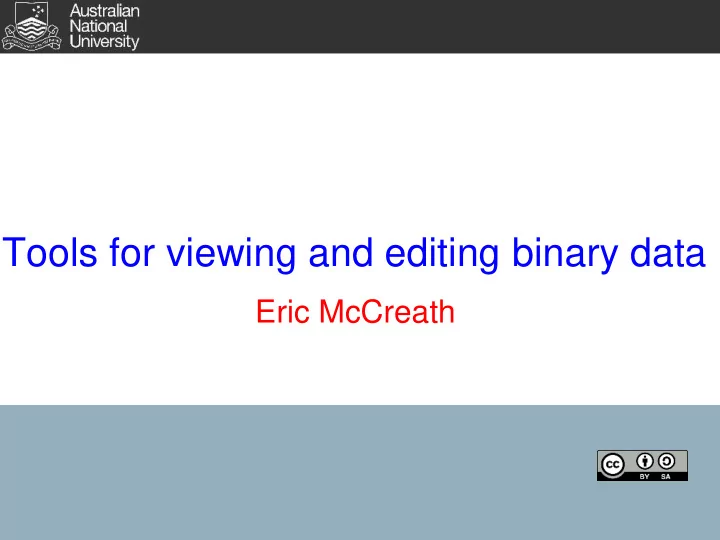

Tools for viewing and editing binary data Eric McCreath
cat and less The cat command will concatenate a list of files and print the result to standard output. It provides a quick way of viewing the contents of a single ASCII file. In the example below (and other examples within these slides) the file called greeting contains the string 'Hello World!\n' $ cat greeting Hello World! The less command provides more control over viewing ASCII files. One can scroll and do simple searches within the text A program called more also enables file perusal and is the origin of the less program While working on the command line, these tools are quicker that bringing up a GUI editor like gedit 2
File redirection and pipes When programs are executed in Unix operating systems, each program has a standard input , standard ouput and standard error data streams. This provides a great deal of flexibility as programs are not tied to particular files. When a program is run from a command shell like bash, the stdout and stderr streams are output to the shell. The stdin stream comes from what is typed into the shell (CTRL-d tells bash there are no more key-strokes to read) In the example below, 'sort' is run and 9, 3 are typed in and ctl-d is pressed: $ sort 9 3 3 9 3
File redirection and pipes Redirection: '<' - used to redirect input data from a file '>' - used to redirect data to a file '>>' - used to append to a file Pipe: '|' - It is used to redirect data from the output of one program to the input of another (programs are normally executed concurrently). In the example below, twice the file 'greeting' is cat and the output is redirected to a new file called 'other'. $ cat greeting greeting > other $ cat other Hello World! Hello World! 4
echo and touch echo prints to standard out the parameter the given to it. $ echo Hello World! Hello World! Combined with redirection it provides a quick way of creating a file with some content $ echo Hello World! > greeting echo by default adds a new line character. To avoid this the -n option must be used touch is used to change the timestamp on a file. It is also a quick way of creating an empty file $ touch newemptyfile $ ls -l newemptyfile -rw-rw-r-- 1 ericm ericm 0 Dec 13 16:05 newemptyfile 5
stat stat will show information about a file $ stat PCP2012.png File: `PCP2012.png' Size: 36802 Blocks: 72 IO Block: 4096 regular file Device: 801h/2049d Inode: 15479095 Links: 1 Access: (0664/-rw-rw-r--) Uid: ( 1000/ ericm) Gid: ( 1000/ ericm) Access: 2012-12-13 10:34:21.912935929 +1100 Modify: 2012-12-07 14:16:47.870797693 +1100 Change: 2012-12-07 14:16:47.870797693 +1100 Birth: - file attempts to determine the type of a file $ file PCP2012.png PCP2012.png: PNG image data, 180 x 234, 8-bit/color RGB, non-interlaced 6
od od is like cat but for viewing files that have binary content. od will show the contents of a file in octal, hex, decimal, character and other formats. $ od PCP2012.png | head -n 1 0000000 050211 043516 005015 005032 000000 006400 044111 051104 $ od -c PCP2012.png | head -n 1 0000000 211 P N G \r \n 032 \n \0 \0 \0 \r I H D R $ od -x PCP2012.png | head -n 1 0000000 5089 474e 0a0d 0a1a 0000 0d00 4849 5244 head -n 1 is used in the example above to show the first line of the file's content 7
hexedit hexedit is a simple program for editing binary data within a file hexedit can also be used for viewing binary data as it provides the hex with the ascii characters in side-by-side columns. In the example below, hexedit is run on the PCP2012.png file. 00000000 89 50 4E 47 0D 0A 1A 0A 00 00 00 0D 49 48 44 52 .PNG........IHDR 00000010 00 00 00 B4 00 00 00 EA 08 02 00 00 00 84 2B F8 ..............+. 00000020 E2 00 00 00 03 73 42 49 54 08 08 08 DB E1 4F E0 .....sBIT.....O. 00000030 00 00 00 19 74 45 58 74 53 6F 66 74 77 61 72 65 ....tEXtSoftware 00000040 00 67 6E 6F 6D 65 2D 73 63 72 65 65 6E 73 68 6F .gnome-screensho 00000050 74 EF 03 BF 3E 00 00 20 00 49 44 41 54 78 9C EC t...>.. .IDATx.. 00000060 9D 77 94 24 57 7D EF 6F 57 AE EA AE D4 39 4D 9E .w.$W}.oW....9M. 8
dd dd provides a simple program for copying one file (or parts of one file) to another file dd provides a lot more control over how a file is copied compared to the cp command. In the example below, the first 5 bytes of the greeting file is copied to the shortgreeting file $ echo Hello World! > greeting $ dd if=greeting bs=1 count=5 of=shortgreeting 5+0 records in 5+0 records out 5 bytes (5 B) copied, 4.1967e-05 s, 119 kB/s $ cat shortgreeting Hello 9
Handy files in Linux /dev/null - an empty file that allows data to be written to it. However, that data is never stored (like a black hole). For e.g. a program that requires certain output to be directed to a file but does not need this output stored. This output could be directed to /dev/null /dev/zero - file containing only zeros. For e.g. to create a big empty file, use dd to copy contents from /dev/zero*. /dev/random - file with random numbers generated on the fly /dev/mem - fille containing an image of the system's main memory /dev/sda - file that contains the raw blocks of the hard disk. Name may vary between Linux distributions 10
Recommend
More recommend